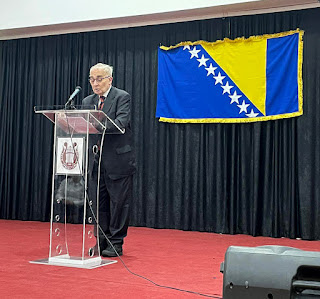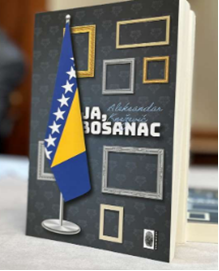|
Alat je sredstvo
koje omogućuje čovjeku mijenjanje svijeta oko sebe.
Alat je svaka
struktura, metoda ili entitet – materijalni ili nematerijalni – koji
omogućuje, olakšava ili usmjerava djelovanje, spoznaju ili komunikaciju s
ciljem postizanja određene funkcije, svrhe ili promjene u svijetu.
Skup Dani Frane
Petrića u Cresu od 1992. godine okuplja filozofe, prirodoznanstvenike i
ostale mislioce oko tematskih okvira budućnosti. Ove godine održani su 33.
Dani Frane Petrića od 21. do 27. rujna 2025. Autor se uključuje 1997., a
2002. preuzima vodeću ulogu u programu “Filozofija i tehnika”, čime započinje
sustavno promišljanje o alatu kao filozofskom pojmu.
Kritika
postojećih definicija
Anićev rječnik
definira alat kao “oruđe ili pribor za izvođenje radnih postupaka”, što je
praktički ograničeno na materijalne alate. Stoga autor ukazuje na potrebu
poopćene definicije koja uključuje i informacijske te nematerijalne alate.
Nova
definicija alata
“Alat je svaka
struktura, metoda ili entitet – materijalni ili nematerijalni – koji
omogućuje, olakšava ili usmjerava djelovanje, spoznaju ili komunikaciju s
ciljem postizanja određene funkcije, svrhe ili promjene u svijetu.” (Microsoft,
365, Copilot).
Ova definicija
proširuje pojam alata na jezična pravila, algoritme, metode, pa čak i
mentalne strukture. Uključuje prirodne alate (mišići ruke i jezika) kao
evolucijski oblikovane sustave koji imaju materijalnu i informacijsku funkciju.
Za stvaranje poopćene definicije alata nužna je je misao o trojedinstvu
informacije, energije i njezinog posebnog oblika materije. Prema Čatiću i
Kneževiću (Filozofska istraživanja 3/2018.), sve što postoji može se opisati
s pomoću ta tri osnovna pojma. Informacija je oblik znanja, strukture i
komunikacije, energija je pokretačka sila a materija fizička manifestacija.
Alat se može smjestiti u sve tri dimenzije, ovisno o njegovoj funkciji i
obliku.
Jezik
kao alat
Jezik u ustima je
materijalni alat za artikulaciju, ali i informacijski alat za prijenos
značenja, emocija i društvene interakcije. Govor se promatra kao produžetak
svijesti, sredstvo kojim se oblikuje i transformira stvarnost.
Genetska i
anatomska istraživanja potvrđuju dugu povijest govora, što dodatno učvršćuje
jezik kao prirodni alat u službi komunikacije i mišljenja.
Stvoreni
alati – razrada i klasifikacija
Postoje dvije
osnovne skupine tih alata. To su: materijalni alati, fizički objekti poput
čekića, svrdla, kalupa i informacijski alati: softveri, algoritmi, programski
jezici, analitički sustavi.
“Alat je sredstvo
djelovanja za sve struke; bilo kuda, alat svuda.” Ova rečenica sažima
univerzalnost alata kao temeljne strukture svake profesije – od filozofije do
medicine ili proizvodne tehnike.
Povijesni
razvoj alata
Sažeto, za
kozmičku i evolucijska kronologiju vrijedi. Svemir je nastao prije ~13,8
milijardi godina. Anorganski polimeri (kamenje): ~4,5 milijardi godina a
organski polimeri: ~4 milijarde godina. Prvi metalni materijal bronca,
načinjen je pred oko 3.000 godina prije nove ere. Dob Homo erectus procjenjuje se na ~7 milijuna godina. Prva stvorena
umjetna tvorevina, artefakt potječe iz Lomekwi 3, Kenija (~3,3 milijuna
godina). To je ujedno u i početak proizvodne tehnike.
Industrijska
revolucija
Kao početak
mehanizacija smatra se doba od 1760. nadalje. U to se ubraja razvoj parnog,
benzinskog i električnog motora. Prijelaz s ručnih alata na alatne strojeve
što omogućuje masovnu proizvodnju.
Suvremeno
doba – Informacijski alati
To doba povezano
je s razvojem interneta i osobnih računala. Tu se javljaju digitalni alati:
softveri, CAD sustavi, komunikacijski alati. Odlika su i konceptualni alati:
analitički alati u znanosti, edukaciji, dizajnu. Virtualni alati redefiniraju
pojam “rada” i “alata” u digitalnom prostoru.
Filozofska
interpretacija alata
“Alat nije samo
produžetak ruke – on je produžetak uma.” Alat je medij između čovjeka i
svijeta, između namjere i ostvarenja. Njegova prisutnost utječe na način
mišljenja, identitet i društvenu interakciju.
Primjer
nematerijalnih alata su politički alati. Sredstva za oblikovanje javnog
mnijenja, donošenje odluka, ostvarenje ciljeva. Glazbeni alati mogu biti
materijalni kao što su klavir, violina, bubnjevi, flauta dok su nematerijalni
glazbena teorija, improvizacija, emocionalna ekspresija.
Opća
definicija alata
“Alat je sredstvo
koje omogućuje čovjeku mijenjanje svijeta oko sebe.” (I. Čatić). Definicija
je sažeta, univerzalna i filozofski potentna. Otvara prostor za daljnju
razradu u kontekstu edukacije, etike, umjetnosti, proizvodne i ostalih
tehnika (M 365. Copilot).
|
|
A tool is a tool
that enables a person to change the world around him.
A tool is any structure, method or entity - material or
immaterial - that enables, facilitates or directs action, cognition or
communication with the aim of achieving a certain function, purpose or change
in the world.
Since 1992, the
Frane Petrić Days gathering in Cres has been gathering philosophers, natural
scientists and other thinkers around thematic frameworks of the future. This
year, the 33rd Frane Petrić Days were held from September 21 to 27, 2025. The
author joined in 1997, and in 2002 he took a leading role in the program
"Philosophy and Technology", which began a systematic reflection on
the tool as a philosophical concept.
Criticism
of existing definitions
Anić's dictionary
defines a tool as "a tool or accessory for performing work
procedures", which is practically limited to material tools. Therefore,
the author points to the need for a generalized definition that includes both
informational and non-material tools.
New
tool definition
"A tool is
any structure, method or entity - material or immaterial - that enables,
facilitates or directs action, cognition or communication with the aim of
achieving a certain function, purpose or change in the world."
(Microsoft, 365, Copilot).
This definition
extends the notion of tools to linguistic rules, algorithms, methods, and
even mental structures. It includes natural tools (hand and tongue muscles)
as evolutionarily shaped systems that have a material and informational
function. To create a generalized definition of a tool, a thought about the
trinity of information, energy and its special form of matter is necessary.
According to Čatić and Knežević (Philosophical research 3/2018), everything
that exists can be described using those three basic terms. Information is a
form of knowledge, structure and communication, energy is a driving force and
matter is a physical manifestation. A tool can be placed in all three
dimensions, depending on its function and form.
Language
as a tool
Language in the
mouth is a material tool for articulation, but also an informational tool for
the transmission of meaning, emotions and social interaction. Speech is seen
as an extension of consciousness, a means by which reality is shaped and
transformed. Genetic and anatomical research confirms the long history of
speech, which further strengthens language as a natural tool in the service
of communication and thought.
Created
tools - development and classification
There are two
basic groups of these tools. These are: material tools, physical objects such
as hammers, drills, molds and information tools: software, algorithms,
programming languages, analytical systems.
"A tool is a
means of action for all professions; anywhere, a tool everywhere." This
sentence summarizes the universality of tools as the fundamental structure of
every profession - from philosophy to medicine or production technology.
Historical
development of the tool
In short, it
applies to cosmic and evolutionary chronology. The universe began ~13.8
billion years ago. Inorganic polymers (rocks): ~4.5 billion years and organic
polymers: ~4 billion years. The first metal material, bronze, was made around
3,000 years before Christ. The age of Homo erectus is estimated at ~7 million
years. The first man-made creation ever created, the artifact comes from
Lomekwi 3, Kenya (~3.3 million years old). It is also the beginning of the
production technique.
The
industrial revolution
The era from 1760
onwards is considered to be the beginning of mechanization. This includes the
development of steam, gasoline and electric engines. Transition from hand
tools to machine tools, which enables mass production.
Modern
age - Information tools
That era is
associated with the development of the Internet and personal computers. This
is where digital tools come in: software, CAD systems, communication tools.
Conceptual tools are also a feature: analytical tools in science, education,
design. Virtual tools redefine the concept of "work" and
"tools" in the digital space.
Philosophical
interpretation of tools
"A tool is
not just an extension of the hand - it is an extension of the mind." A
tool is a medium between man and the world, between intention and
realization. Its presence affects the way of thinking, identity and social
interaction.
An example of
intangible tools are political tools. Means for shaping public opinion,
making decisions, achieving goals. Musical tools can be material such as piano,
violin, drums, flute, while immaterial are musical theory, improvisation,
emotional expression.
General
definition of tools
"A tool is a
tool that enables a person to change the world around him." (I. Čatić).
The definition is concise, universal and philosophically potent. It opens up
space for further elaboration in the context of education, ethics, art,
production and other techniques (M 365. Copilot).
|



